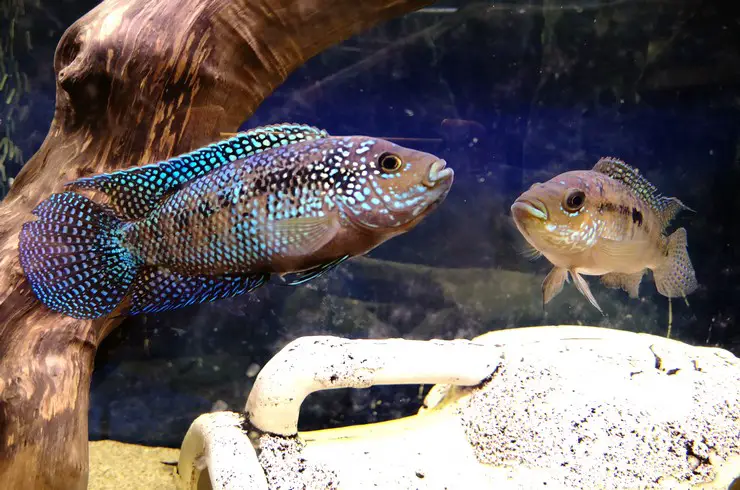Natural mutations in some genes in fish can lead to very unusual coloration. She is often so attractive that she overshadows the natural individual. Tsichlazoma Blue Dempsey is a good example of this. The origin of this fish is still vague: some believe that this is a natural mutation, others that the fish is a hybrid obtained from crossing with other species. But while scientists figure out where the truth is, cichlid hobbyists, continue to maintain and enjoy the beauty of this magnificent fish.
General information
Cichlazoma Blue Dempsey (Rocio octofasciata “Blue Jack Dempsey”) is a freshwater ray-finned fish from the Cichlid family. It is one of the most beautiful aquarium cyclases due to its rich blue color with a shimmering effect. Blue Dempsey is the color morph of the well-known eight-striped cichlazoma. The origin of this variety is still not completely clear. It is believed that the first specimens of these fish were obtained by the Argentine ichthyologist Hector Luzardo in 1985. The form is most likely a natural mutation rather than a hybrid. Since the fry did not have such a wonderful color and was much smaller than their “usual” relatives, they were simply discarded during breeding.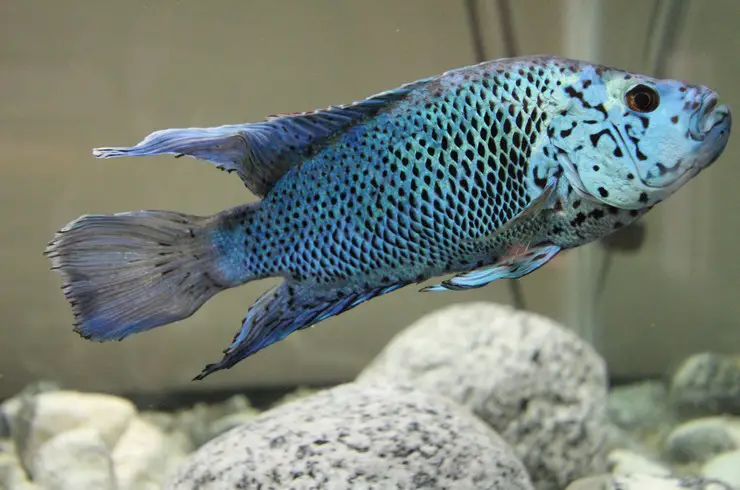
However, Blue Dempsey did not adopt the endurance of the ancestral form of the cichlazoma. Due to long-term crossings, the fish’s immunity has weakened. And the maximum size has decreased. The fish is picky enough in keeping and breeding. When breeding, only about 20% of the fry acquire a blue color.
Prefers the lower layers of the aquarium. Able to recognize her master.
Appearance
Cichlazoma Blue Dempsey has a compact and stocky body. The maximum length of an adult is 20 cm, while ordinary eight-striped cichlazomas can grow up to 25 cm. The head is large with large eyes and a mouth surrounded by massive lips. The dorsal and anal fin are elongated, the tail is wide, single-lobed.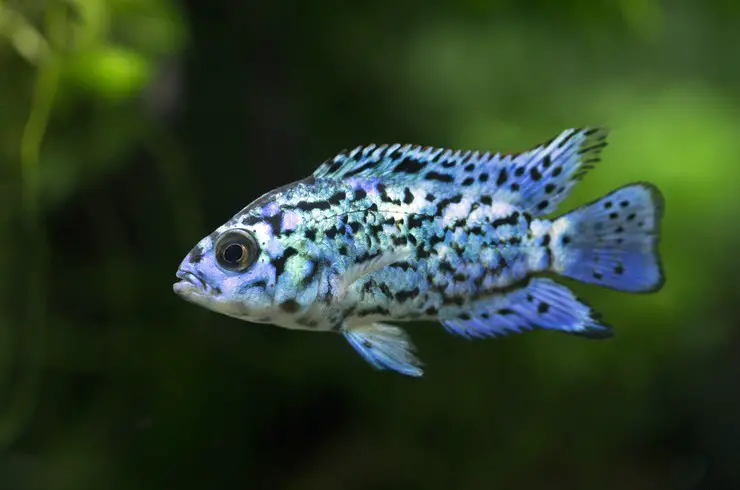
The main advantage of this cichlazoma is its spectacular body color: the almost black body of the fish is strewn with a large number of bright turquoise spots with a specific neon glow. The juveniles do not have such a bright color, the fry is light brown with small blotches of blue. The color intensity increases as the fish matures. Also, the color saturation can change under poor conditions, stress, in moments of aggression, and during the spawning period.
Habitat
The progenitor of Blue Dempsey cichlizoma is widespread in Central America: from southern Mexico to Honduras.
Fish prefer swampy areas with warm and dark tropical water. They live in low-flowing or stagnant bodies of water. They can be found in densely vegetated canals and drainage ditches with a sandy bottom.
Care and maintenance
The aquarium for keeping Blue Dempsey cichlazoma should be at least 150 liters per pair of individuals. And even more when settling with other compatible species. An ideal accommodation option would be a species aquarium in which a male and a female will live.
The soil is laid at the bottom of the aquarium, the best choice would be coarse sand with a layer of 5-6 cm. Cichlids love to dig in it, so pebbles with sharp edges are excluded. Natural stones and driftwood, folded in such a way as to form a large number of shelters, are perfect as decorations. Do not forget to leave open areas for the fish to swim.
Unfortunately, live plants are not very compatible with Blue Dempsey cichlazomas, because they are easily destroyed and dug up by them. Therefore, you can do without them, in extreme cases, rigid-leaved species are used – anubias, echinoderms, – planted in pots.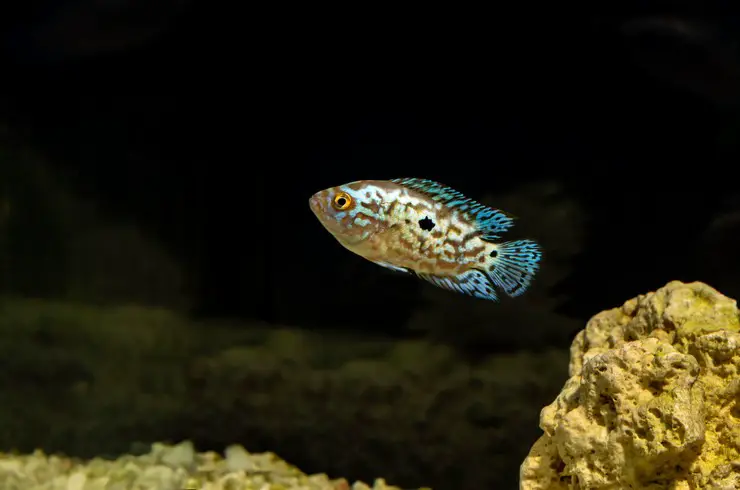
Like any large fish, Blue Dempsey cichlazomas produce a significant amount of waste in the aquarium, so good filtration is the first thing to take care of. It is best to use a high-performance external filter. It is also worth installing a quiet and powerful compressor that will provide oxygen to the fish and beneficial bacteria. Cichlazoma Blue Dempsey is a thermophilic tropical fish and will feel comfortable at temperatures around 26 ° C, so the thermostat is just as important. Lighting should not be bright, fish love twilight.
A prerequisite for maintaining a comfortable environment in Blue Dempsey cichlazoma aquariums is weekly water changes – up to 20% of the volume. Use Tetra ToruMin Conditioner with Natural Peat Extract to recreate the black tropical water effect in your aquarium.
Compatibility
Unlike the progenitor species – the eight-striped cichlazoma – Blue Dempsey has a rather calm character. This is especially pronounced in young individuals, which sometimes can even be called shy. As they grow older, the fish become more aggressive, especially during the spawning period. Also, an insufficient volume of the aquarium can provoke a fight. In such cases, the pair must be planted.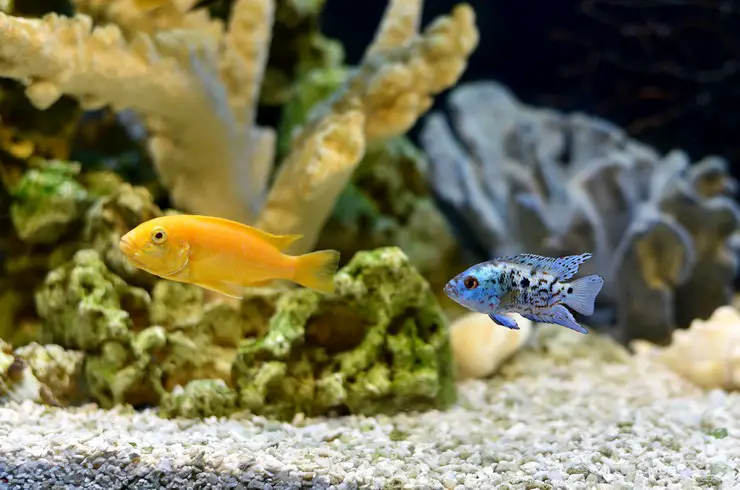
It is strongly not recommended to add small tropical fish (neons, tetras, guppies, danios, etc.) to the Blue Dempsey aquarium. Sooner or later, they will be eaten by colorful predators.
Cichlids close in size are best suited for joint content: eight-lane, diamond, Managuan. You can add pangasius, pterygoplicht or black pacu.
Feeding Blue Dempsey
Cichlazoma Blue Dempsey is a predatory fish; shellfish, worms, insects, and small fish predominate in its natural diet. When kept at home, feeding these fish live or frozen food is not recommended as they are unbalanced, do not contain useful vitamins and, moreover, pose a potential danger of contaminating the aquarium. Liver or minced meat from warm-blooded animals is also categorically contraindicated. But high-quality dry food for large cichlids is devoid of these disadvantages, and regular feeding with them will ensure the health and longevity of your fish.
Cichlazom Blue Dempsey are perfect:
- Tetra Cichlid Sticks is the main universal food for all large cichlids. It consists of sticks floating on the surface of the water, which gives them the appearance of a natural natural food. The composition fully meets the needs of the body of cichlids in the consumption of proteins and special amino acids.
- Tetra Cichlid XL Flakes is a large flakes basic food for all cichlids with a special vitamin complex. Differs in a high content of proteins and vegetation.
- Alternatively, TetraMin XL Flakes, a complete blend of high quality flakes with functional ingredients, provides a complete daily nutrition for larger ornamental fish. Supports healthy growth and vitality of fish.
Cichlazoma Blue Dempsey is prone to obesity, so you need to feed her in small portions 2-3 times a day.